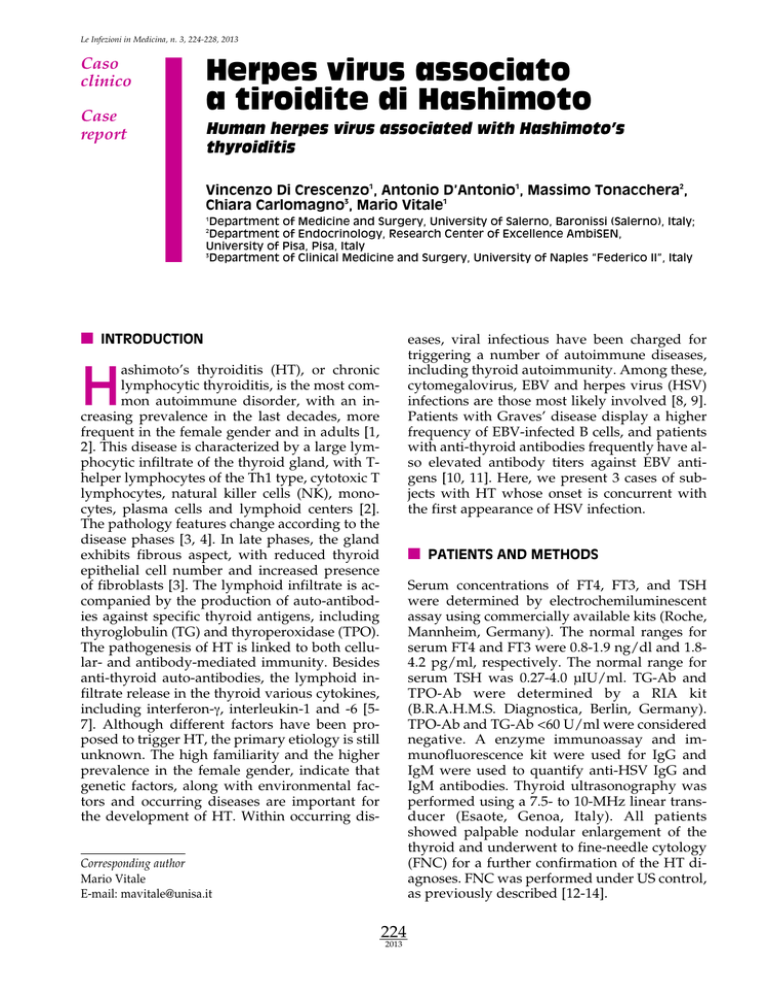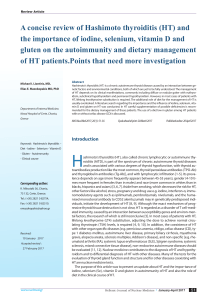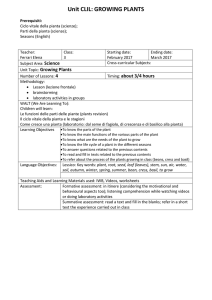
Le Infezioni in Medicina, n. 3, 224-228, 2013
Caso
clinico
Case
report
Herpes virus associato
a tiroidite di Hashimoto
Human herpes virus associated with Hashimoto’s
thyroiditis
Vincenzo Di Crescenzo1, Antonio D’Antonio1, Massimo Tonacchera2,
Chiara Carlomagno3, Mario Vitale1
1
Department of Medicine and Surgery, University of Salerno, Baronissi (Salerno), Italy;
Department of Endocrinology, Research Center of Excellence AmbiSEN,
University of Pisa, Pisa, Italy
3
Department of Clinical Medicine and Surgery, University of Naples “Federico II”, Italy
2
n INTRODUCTION
eases, viral infectious have been charged for
triggering a number of autoimmune diseases,
including thyroid autoimmunity. Among these,
cytomegalovirus, EBV and herpes virus (HSV)
infections are those most likely involved [8, 9].
Patients with Graves’ disease display a higher
frequency of EBV-infected B cells, and patients
with anti-thyroid antibodies frequently have also elevated antibody titers against EBV antigens [10, 11]. Here, we present 3 cases of subjects with HT whose onset is concurrent with
the first appearance of HSV infection.
ashimoto’s thyroiditis (HT), or chronic
lymphocytic thyroiditis, is the most common autoimmune disorder, with an increasing prevalence in the last decades, more
frequent in the female gender and in adults [1,
2]. This disease is characterized by a large lymphocytic infiltrate of the thyroid gland, with Thelper lymphocytes of the Th1 type, cytotoxic T
lymphocytes, natural killer cells (NK), monocytes, plasma cells and lymphoid centers [2].
The pathology features change according to the
disease phases [3, 4]. In late phases, the gland
exhibits fibrous aspect, with reduced thyroid
epithelial cell number and increased presence
of fibroblasts [3]. The lymphoid infiltrate is accompanied by the production of auto-antibodies against specific thyroid antigens, including
thyroglobulin (TG) and thyroperoxidase (TPO).
The pathogenesis of HT is linked to both cellular- and antibody-mediated immunity. Besides
anti-thyroid auto-antibodies, the lymphoid infiltrate release in the thyroid various cytokines,
including interferon-γ, interleukin-1 and -6 [57]. Although different factors have been proposed to trigger HT, the primary etiology is still
unknown. The high familiarity and the higher
prevalence in the female gender, indicate that
genetic factors, along with environmental factors and occurring diseases are important for
the development of HT. Within occurring dis-
H
n PATIENTS AND METHODS
Serum concentrations of FT4, FT3, and TSH
were determined by electrochemiluminescent
assay using commercially available kits (Roche,
Mannheim, Germany). The normal ranges for
serum FT4 and FT3 were 0.8-1.9 ng/dl and 1.84.2 pg/ml, respectively. The normal range for
serum TSH was 0.27-4.0 µIU/ml. TG-Ab and
TPO-Ab were determined by a RIA kit
(B.R.A.H.M.S. Diagnostica, Berlin, Germany).
TPO-Ab and TG-Ab <60 U/ml were considered
negative. A enzyme immunoassay and immunofluorescence kit were used for IgG and
IgM were used to quantify anti-HSV IgG and
IgM antibodies. Thyroid ultrasonography was
performed using a 7.5- to 10-MHz linear transducer (Esaote, Genoa, Italy). All patients
showed palpable nodular enlargement of the
thyroid and underwent to fine-needle cytology
(FNC) for a further confirmation of the HT diagnoses. FNC was performed under US control,
as previously described [12-14].
Corresponding author
Mario Vitale
E-mail: [email protected]
224
2013
n RESULTS
echoic micro-spots (<1 cm of diameter). IgM
and IgG antibodies to Herpes simplex virus were
positive. TSH and thyroid hormones indicated
a moderate hyperthyroidism and thyroid autoantibodies were positive (Table 1).
Patient 1
A 32-year-old woman presented to our attention with rapid heartbeat (80 beats a minute)
and slight pain at palpation in the thyroid region. The thyroid gland was slightly enlarged
at palpation. She referred weight loss (6 kg in 3
months), anxiety and irritability, and difficulty
sleeping. She referred also to have had herpes
labialis for the first time 3 months before, accompanied by moderate fever (<38°C). Ultrasound thyroid examination revealed a hypoechoic micronodular pattern. IgM and IgG antibodies to Herpes simplex virus were positive.
TSH and thyroid hormones indicated a moderate hyperthyroidism and thyroid auto-antibodies were positive (Table 1).
Patient 3
A 57-year-old woman presented to our attention with rapid heartbeat (80 beats a minute),
slight pain at palpation in the thyroid region,
the thyroid was enlarged and irregular at palpation. She referred sweating, anxiety and irritability. She referred herpes labialis for the first
time 6 months before. Sonographic presentation was characterized by multiple hypo-echoic
nodules, with a surrounding heterogeneous
echo-texture mostly hypo-echoic. Major nodules were 2.3x1.8x1.8 mm and 2.5x2.5x1.8 mm
(width x length x thickness). IgG antibodies to
Herpes simplex virus were positive, while IgM
were negative. TSH and thyroid hormones indicated a subclinical hyperthyroidism and thyroid auto-antibodies were positive (Table 1).
The patient was affected by type 2 insulin-dependent diabetes diagnosed 18 years before,
with retinopathy, cataracts, and initial foot
complications [15]. Thyroid nodules were subjected to fine needle aspiration cytology. One
nodule was classified as indeterminate lesion,
negative for RET/PTC and BRAF mutation and
subjected to clinical follow-up [16-18].
Patient 2
A 27-year-old woman presented to our attention with tachycardia (85 beats a minute), slight
pain at palpation in the thyroid region, the thyroid was moderately enlarged and irregular at
palpation.
She referred weight loss (4 kg in 3 months),
sweating, anxiety and irritability. She referred
herpes labialis for the first time 2 months before, accompanied by fever (up to 38°C). Sonographic presentation was characterized by heterogeneous echo-texture with multiple hypo-
Table 1 - Clinical, thyroid ultrasonographic and serological features of patients.
Patient 1
Patient 2
Patient 3
Age (yrs)
32
27
57
HSV onset (months before observation)
3
2
6
Sonography suggestive for HT
Yes
Yes
Yes in a
multinodular
goiter pattern
Pain at palpation of the thyroid region
Yes
Yes
Yes
anti-HSV IgM (negative <10)
17.6
21.2
8.3
anti-HSV IgG (negative <0.9)
48.2
57.2
54.4
TSH (IU/mL) 0.27-4.0
0.02
0.03
0.08
FT3 (ng/mL) 2.9-5.8
6.8
7.2
5.7
FT4 (ng/mL) 7.8-14.2
15.4
12.3
9.8
TG-Ab <60
183
329
41
TPO-Ab <60
3455
3041
4685
HT, Hashimoto’s thyroiditis; TG, thyroglobulin; TPO, thyroperoxidase.
225
2013
n DISCUSSION
and patient 2, strongly supported an etiological
role for HSV infection in the development of
HT. In patient 3, a direct correlation between
HSV infection and HT was less evident as only
the IgG type of anti-HSV were present. However, this was an older subject with concurrent infectious diseases that can make the clinical
course more complicated [34]. HSV is among
the viruses known to affect the upper aerodigestive tract.
Recurrent herpes labialis is the most common
clinical manifestations of first-episode HSV infection. Gingivostomatitis and pharyngitis are
also common clinical manifestation of HSV infection. HSV infection has been proposed as etiologic factors of different tumors, including
breast cancer, thyroid cancer and lymphomas
[35].
Virus infection of thyroid cells in culture were
shown to act as antigen presenting cells and
therefore might be involved in autoimmunity.
Induction of HLA-DR expression was shown
on thyroid follicular cells infected in vitro by cytomegalovirus [36].
Patients with Graves’ disease display a higher
frequency of EBV-infected B cells secreting antibody to TSH receptor [11]. Subjects with thyroid autoimmunity have more frequently elevated antibody titers against EBV antigens [12].
Human HSV-6 DNA has been detected in HT
tissue specimens, but not in tissues from other
thyroid diseases such as multinodular goiter
[10]. HSV has occasionally been detected in thyroid tissue of patients with thyroid autoimmunity and other diseases [37-40].
Very recently, experimental evidence supporting a role for HSV in the etiology of HT has
been provided. The presence and transcriptional state of HSV-6 was demonstrated in thyroid
fine needle aspirates and peripheral blood
mononuclear cells from HT patients [41]. Noteworthy, thyrocytes from fine needle aspirates
displayed a 100-fold higher HSV-6 DNA load
compared to infiltrating lymphocytes, strongly
supporting a direct thyroid infection. In conclusion, although the role of HSV in HT etiology is
still a debated issue, the three cases presented
in this study support the possibility that HSV
infection may trigger HT.
Usually, HT begins as a gradual enlargement of
the thyroid gland with a progressive development of hypothyroidism. It is often discovered
by the patient, who finds symptoms of
hypo/hyperthyroidism and a vague discomfort
in the neck.
Hashitoxicosis is a transient hyperthyroidism
caused by inflammation, occurring often at onset of Hashimoto’s thyroiditis, characterized by
an excessive release of thyroid hormone. Major
clinical signs include weight loss, weakness, fatigue, intolerance to heat, sweating, hyperactivity, irritability, anxiety, loss of libido, polyuria,
polydipsia, and hair loss.
Possible HT complications include papillary
carcinoma (PTC) and, rarely, primary nonHodgkin lymphoma (PTL) in addition to hypothyroidism [3, 5, 6, 12, 19-22]. Therefore a direct evaluation of diffuse or nodular thyroid enlargement in case of HT may be needed.
Fine-needle cytology (FNC) is widely used in
the diagnosis of thyroid nodules, and the application of molecular techniques to FNC has dramatically increased its sensitivity, including in
cases of HT with diffuse or nodular enlargement [5, 23-31].
An effective FNC diagnosis avoids useless diagnostic surgery or leads to the proper surgical
treatment, when needed [32]. These advantages
are enhanced in the case of HT which does not
require surgical treatment, especially in elderly
patients in which any surgery is generally more
burdensome, complex and expensive than
younger patients [32, 33].
In some cases, the onset of HT can be recognized by the occurrence of symptoms of
hashitoxicosis.
The thyrotoxicosis in HT as well as in subacute
thyroiditis or De Quervain’s thyroiditis, is induced by leakage of intra-thyroidal hormones
into the circulation caused by damage to thyroid epithelial cells from inflammation. Thyroid
inflammation can be sustained by an autoimmune process, like in HT, or by a viral infection
like in De Quervain’s thyroiditis. Hashitoxicosis was diagnosed in the three patients reported
in this study.
The presence of anti HSV IgM, the exhibition of
a first-episode of cold sores few months before
and the tenderness of the thyroid in patient 1
Keywords: Hashimoto thyroiditis, autoimmune
disease.
226
2013
SUMMARY
Hashimoto’s thyroiditis is the most frequent autoimmune disease with genetic and environmental
aetiologies. Viral infections have been postulated
as one of the factors that may trigger autoimmune
diseases. Many studies suggest that Herpes simplex
virus infections are involved in a variety of au-
toimmune diseases. We report the case of three patients presenting for the first time herpes labialis a
few months before the onset of hashitoxicosis.
Serological and clinical exams support the possible
role of human herpes viruses in the aetiology of
Hashimoto’s thyroiditis.
RIASSUNTO
La tiroidite di Hashimoto è la più frequente malattia autoimmunitaria, con un’eziologia genetica e ambientale.
Le infezioni virali sono considerate come uno dei possibili fattori scatenanti le malattie autoimmuni. Molti
studi indicano che i virus Herpes simplex sono coinvolti in diverse malattie autoimmuni. In questo studio
riportiamo i casi di 3 pazienti che presentavano per la
prima volta herpes labiale pochi mesi prima della comparsa di hashitossicosi.
Gli esami sierologici e clinici erano in favore di un possibile ruolo degli Herpes virus nella eziologia della tiroidite di Hashimoto.
[10] Fan J.L., Desai R.K., Dallas J.S., Wagle N.M.,
Seetharamaiah G.S., Prabhakar B.S. High frequency
of B cells capable of producing anti-thyrotropin receptor antibodies in patients with Graves’ disease.
Clin. Immunol. Immunopathol. 71, 69-74, 1994.
[11] Vrbikova J., Janatkova I., Zamrazil V., Tomiska
F., Fucikova T. Epstein-Barr virus serology in patients with autoimmune thyroiditis. Exp. Clin. Endocrinol. Diabetes 104, 89-92, 1996.
[12] Zeppa P., Varone V., Cozzolino I., Salvatore D.,
Vetrani A., Palombini L., Fine needle cytology and
flow cytometry of ectopic cervical thymoma: a case
report. Acta Cytol. 54, 998-1002, 2010.
[13] Cozzolino I., Nappa S., Picardi M., et al. Clonal
B-cell population in a reactive lymph node in acquired immunodeficiency syndrome. Diagn. Cytopathol. 37, 910-914, 2009.
[14] Cozzolino I., Zeppa R., Zeppa P. Lymph nodal
Merkel cell carcinoma: primary tumor or metastasis
from unknown primary site? J. Cutan. Pathol. 38, 836837, 2011.
[15] Pascale R., Vitale M., Zeppa P., Russo E., Esposito S. Diabetic foot: definitions. Infezioni in Medicina 20
(Suppl. 1), 5-7, 2012.
[16] Guerra A., Marotta V., Deandrea M., et al. BRAF
(V600E ) associates with cytoplasmatic localization of
p27kip1 and higher cytokeratin 19 expression in papillary thyroid carcinoma. Endocrine 2012.
[17] Guerra A., Di Stasi V., Zeppa P., Faggiano A.,
Marotta V. and Vitale M. BRAF (V600E) assessment
by pyrosequencing in fine needle aspirates of thyroid
nodules with concurrent Hashimoto’s thyroiditis is a
reliable assay. Endocrine In press, 2013.
[18] Marotta V., Guerra A., Sapio M.R., Vitale M.
n REFERENCES
[1] Tunbridge W.M., Brewis M., French J.M., et al.
Natural history of autoimmune thyroiditis. Br. Med.
J. (Clin Res Ed) 282, 258-262, 1981.
[2] Caturegli P., Kimura H., Rocchi R. and Rose N.R.
Autoimmune thyroid diseases. Curr. Opin. Rheumatol. 19, 44-48, 2007.
[3] Weetman A.P. Autoimmune thyroid disease:
propagation and progression. Eur. J. Endocrinol. 148,
1-9, 2003.
[4] Zeppa P., Cozzolino I., Peluso A.L., et al. Cytologic, flow cytometry, and molecular assessment of
lymphoid infiltrate in fine-needle cytology samples
of Hashimoto thyroiditis. Cancer 117, 174-184, 2009.
[5] Salgame P., Abrams J.S., Clayberger C., et al. Differing lymphokine profiles of functional subsets of
human CD4 and CD8 T cell clones. Science 254, 279282, 1991.
[6] Romagnani S. Lymphokine production by human
T cells in disease states. Annu. Rev. Immunol. 12, 227257, 1994.
[7] Salzano M., Russo E., Postiglione L., et al. Interferon-gamma inhibits integrin-mediated adhesion to
fibronectin and survival signaling in thyroid cells. J.
Endocrinol. 215, 439-444, 2012.
[8] Mori K., Yoshida K. Viral infection in induction of
Hashimoto’s thyroiditis: a key player or just a bystander? Curr. Opin. Endocrinol. Diabetes Obes. 17,
418-424, 2010.
[9] Thomas D., Liakos V., Michou V., et al. Detection
of herpes virus DNA in post-operative thyroid tissue
specimens of patients with autoimmune thyroid disease. Exp. Clin. Endocrinol. Diabetes 116, 35-39, 2008.
227
2013
[30] Kim M.I., Alexander E.K. Diagnostic use of molecular markers in the evaluation of thyroid nodules.
Endocr. Pract. 18, 796-802, 2012.
[31] Zeppa P., Cozzolino I., Peluso A.L., et al. Cytologic, flow cytometry, and molecular assessment of
lymphoid infiltrate in fine-needle cytology samples
of Hashimoto thyroiditis. Cancer 117, 174-184, 2009.
[32] Gervasi R., Orlando G., Lerose M.A., et al. Thyroid surgery in geriatric patients: a literature review.
BMC Surg. 12 (Suppl. 1), S16, 2012.
[33] Passler C., Avanessian R., Kaczirek K., Prager G.,
Scheuba C., Niederle B. Thyroid surgery in the geriatric patient. Arch. Surg. 137, 1243-1248, 2002.
[34] Vitale M., Zeppa P., Esposito I., Esposito S. Infected lesions of diabetic foot. Infezioni in Medicina 20
(Suppl. 1), 14-19, 2012.
[35] Tsai J.H., Tsai C.H., Cheng M.H., Lin S.J., Xu
F.L., Yang C.C. Association of viral factors with nonfamilial breast cancer in Taiwan by comparison with
non-cancerous, fibroadenoma, and thyroid tumor
tissues. J. Med. Virol. 75, 276-281, 2005.
[36] Khoury E.L., Pereira L., Greenspan F.S. Induction of HLA-DR expression on thyroid follicular cells
by cytomegalovirus infection in vitro. Evidence for a
dual mechanism of induction. Am. J. Pathol. 138,
1209-1223, 1991.
[37] Di Luca D., Dolcetti R., Mirandola P., et al. Human herpesvirus 6: a survey of presence and variant
distribution in normal peripheral lymphocytes and
lymphoproliferative disorders. J. Infect. Dis. 170, 211215, 1994.
[38] D’Antonio A., Paolella G., Zeppa P. Rapidly
growing intraparotid mass in a young child. J. Craniofac. Surg. 23, e305-306, 2012.
[39] Stanzione B., Cozzolino I., Arpino G., Vigliar E.,
Virginia S.F., Zeppa P. Multiple metachronus proliferative fasentis occurring in different anatomic regions: a case report and review of the literature.
Pathol. Res. Pract. 208, 126-130, 2012.
[40] Santini M., Fiorelli A., Vicidomini G., Laperuta
P., Di Crescenzo V.G. Iatrogenic air leak successfully
treated by bronchoscopic placement of undirectional
endobronchial valves. Ann. Thorac. Surg. 89, 20072010, 2010.
[41] Caselli E., Zatelli M.C., Rizzo R., et al. Virologic
and immunologic evidence supporting an association between HHV-6 and Hashimoto’s thyroiditis.
PLoS Pathog. 8, e1002951, 2012.
RET/PTC rearrangement in benign and malignant
thyroid diseases: a clinical standpoint. Eur. J. Endocrinol. 165, 499-507, 2011.
[19] Liu L.H., Bakhos R., Wojcik E.M. Concomitant
papillary thyroid carcinoma and Hashimoto’s thyroiditis. Semin. Diagn. Pathol. 18, 99-103, 2001.
[20] Lee J.H., Kim Y., Choi J.W., Kim Y.S. The association between papillary thyroid carcinoma and histologically proven Hashimoto’s thyroiditis: a metaanalysis. Eur. J. Endocrinol. 168, 343-349, 2013.
[21] Bellevicine C., Malapelle U., Iaccarino A., et al.
Foamy gland pancreatic ductal adenocarcinoma diagnosed on EUS-FNA: a histochemical, immunohistochemical, and molecular report. Diagn. Cytopathol.
41, 77-80, 2013.
[22] Larsen P.R., Berry M.J. Type I iodothyronine
deiodinase: unexpected complexities in a simple
deiodination reaction. Thyroid 4, 357-362, 1994.
[23] Caleo A., Vigliar E., Vitale M., et al. Cytological
diagnosis of thyroid nodules in Hashimoto thyroiditis in elderly patients. BMC Surg. In press, 2013.
[24] Di Crescenzo V., Garzi A., Petruzziello F., Catalano L., Zeppa P., Vitale M. Nodular goiter with
amyloid deposition in an elderly patient: fine-needle
cytology diagnosis and review of the literature. BMC
Surg. In press, 2013.
[25] Guerra A., Di Crescenzo V., Garzi A., et al. Diagnostic utility of BRAFV600E mutation testing in
thyroid nodules in elderly patients. BMC Surg. In
press, 2013.
[26] Vigliar E., Caleo A., Vitale M., Di Crescenzo V.,
Garzi A., Zeppa P. Early cytological diagnosis of extranodal stage I, primary thyroid Non-Hodgkin lymphoma in elderly patients. Report of two cases and
review of the literature. BMC Surg. In press, 2013.
[27] Bellevicine C., Cozzolino I., Malapelle U., Zeppa
P., Troncone G. Cytological and molecular features of
papillary thyroid carcinoma with prominent hobnail
features: a case report. Acta Cytol. 56, 560-564, 2012.
[28] Cooper D.S., Doherty G.M., Haugen B.R., et al.
Revised American Thyroid Association management
guidelines for patients with thyroid nodules and differentiated thyroid cancer. Thyroid 19, 1167-1214,
2009.
[29] Alexander E.K., Kennedy G.C., Baloch Z.W., et
al. Preoperative diagnosis of benign thyroid nodules
with indeterminate cytology. N. Engl. J. Med. 367,
705-715, 2012.
228
2013



